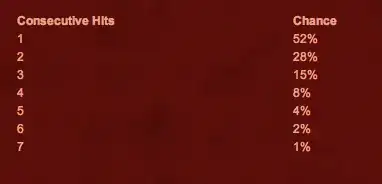Flipping a coin is an independent event, and has a chance of 50%. So Lets say that I flip a coin 10 times, and if the first 5 flips are heads. Then the probability of the next flip being a tails, is higher(so as to satisfy the 50% chance), How can we calculate the increase in probability of this happening.
I read an article about a roulette wheel. In a roulette wheel the reds and blacks have an equal chance of hitting.(ignoring the zero) just like a coin flip. Now the article said that if you place a bet on red, then you have a 52% chance of losing(as this includes the zero).
If you bet on red again, then you have only a 28% chance of losing in the second consecutive bet.
And the chances of a red coming keeps increasing each flip.

My Question is that, since these events are independent, then shouldnt the probability of me winning or losing be 50% everytime. May it be 10 consecutive blacks..
Also, if to satisfy the 50% over a large sample size, the probability of red hitting does increase, then how do we calculate it?